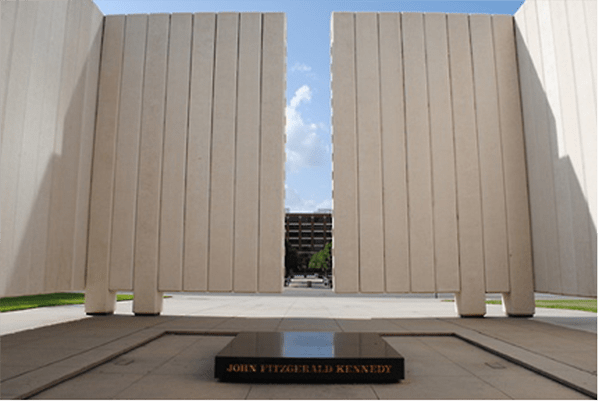
The John Fitzgerald Kennedy Memorial stands in downtown Dallas, blocks from where the president was assassinated. (Reem Abdelrazik / The Daily Campus)
The opening of the George W. Bush Library brings with it not only many important faces – like those of the five living presidents – but also the hope of a polished new reputation.
Fifty years ago this November, another president came to visit the lone-star state setting in motion events that would tarnish Dallas’s reputation for years to come. The assassination of President John F. Kennedy left the nation reeling, and in the aftermath Dallas was labeled not only as the place where Kennedy was killed, but also as the “City of Hate.”
“The motorcade was to be a very short trip [through] downtown Dallas and there were hundreds of people that poured out into the streets, who were terribly excited,” said Nicola Longford, the executive director of the Sixth Floor Museum. “When he got there it was just overwhelmingly positive, with so many crowds and people cheering him on. It was a beautiful day.”
But that day was about to turn ugly. According to Longford, people were already nervous about the president visiting Dallas because the state played home to certain right-wing extremism, which raised concerns about Kennedy’s safety. But when they arrived it seemed like all the fussing was for nothing.
“For the assassination to have taken place right outside these doors was just a tremendous shock,” Longford said, referring to the street right outside the Texas School Book Depository – now the Sixth Floor Museum – where many tourists stand taking pictures. “Nobody could really believe it. And then that weekend was just chaos.”
From then on Dallas and, according to Longford, Texas in general was left with the stigma of the event.
“People from Dallas and from Texas were treated badly and people spoke to them in accusatory tones. ‘You killed our president’ or ‘Oh, you’re from Texas, the city that kills presidents,'” Longford said.
“People in Dallas were ashamed and shocked that this took place in their city and I think that still reverberates a little bit today. Dallas has worked very hard to overcome that shame and I think we’ve become a better city.”
Dallas has since thrived as a city, turning over some of its politics and transforming the city for the better. Some of these transformations included upgrading City Hall and the library system, developing a regional international airport and the growth of the downtown Arts District. Added to that list is now the George W. Bush Presidential Library and Museum.
“It was with the fortitude of the community leaders after the assassination to recognize that we had to work to bring the city together and to move on,” Longford said. “I think Dallas is known for its vision and creativity and onward-looking approach as we continue to build and attract people from all over the world.”
While the city has recovered, echoes of the past still linger. Longford said that the Sixth Floor Museum attracts about 350,000 people every year from all over the world that long to solve the “puzzle” of the Kennedy assassination.
Mayor Mike Rawlings, along with the Sixth Floor Museum, has also been planning an event that will mark the 50th anniversary of the JFK assassination.
“It’s a terribly sad story. It’s a complicated story,” Longford said.
“But I think it’s important that the city recognize in some official way that this event happened here fifty years ago and that to look at where Dallas is now.”








